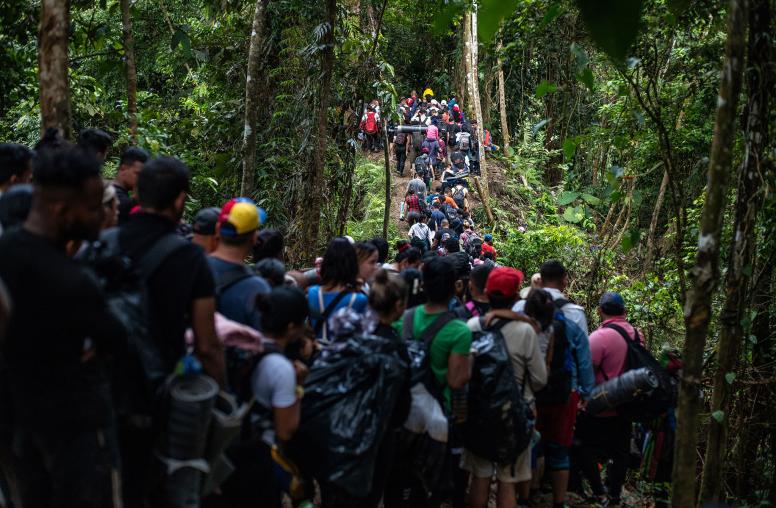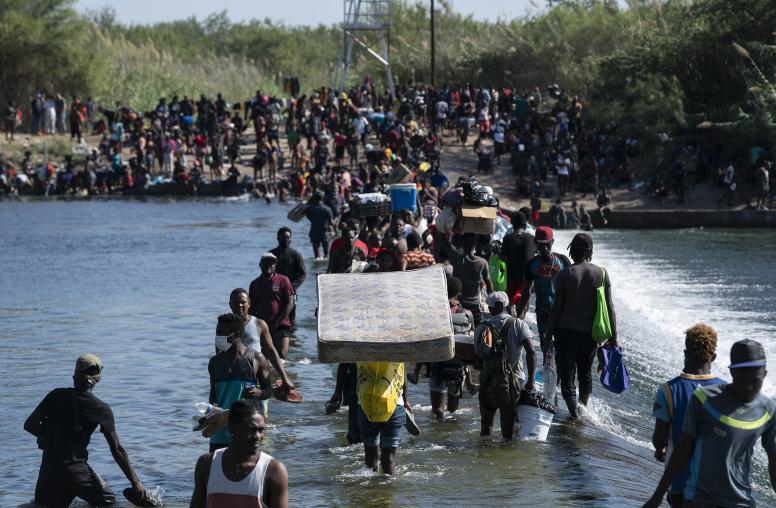Five Key Considerations To Make the U.S. Global Fragility Strategy Work
These benchmarks are critical to the successful implementation of a new U.S. approach to mitigate conflict abroad.
Even as the public debate over the U.S. military withdrawal from Afghanistan continues, the State Department and USAID are quietly putting plans in place to test a new approach to conflicts overseas. Drawing on the hard-earned lessons from Afghanistan and Iraq over the past two decades, this approach would have the United States rely far less on military power and far more on sustained — but much less costly — diplomacy and closely coordinated development investments. If fully implemented, consistent with the recently enacted Global Fragility Act, this new effort promises to help stabilize countries in their recovery from COVID-19 and the knock-on shocks to their economies.

With bipartisan support and a strong strategy developed under the previous administration, the Biden administration has been handed a promising opportunity. The new policy makes preventing internal conflicts a U.S. foreign policy priority and articulates a set of peacebuilding and do-no-harm principles that federal agencies should adhere to. These commitments are backed up by a pledge to increase U.S. investments in peacebuilding and governance programs, and to stay the course through 10-year partnerships with local and international actors. As the world has become less stable in the aftermath of the pandemic, a trend that could well be exacerbated by climate change, the case for doing more to mitigate conflicts abroad and doing it better is as compelling as ever. The risk that domestic and regional wars could become flashpoints between great powers in these countries and spark a global conflagration only makes this danger more urgent.
If the last administration had the relatively easy task of releasing a strategy document, the new one has the less enviable job of putting it into practice. No decision will be more critical to the new approach’s success than the identification of countries and regions where the United States will seek to focus its energy and resources, a process that is nearing completion in the U.S. government. The new approach commits the United States to assess opportunities for progress in conflict-affected countries before it engages. While life-saving emergency relief is needed in conflict environments strictly on humanitarian grounds, agencies will need to be much more discerning about how they can incentivize good governance and help deliver effective development and security assistance in these settings.
Under the GFA, not only are agencies required to determine the relevance of a conflict to U.S. national security interests, they also must assess the level of violence and fragility as well as the commitment and capacity of government and civil society leaders in the affected country. Will the administration adhere to these conditions? How will we know whether the slate of countries soon-to-be announced as focus countries under the GFA are promising?
Building on this guidance, here are five key benchmarks that will set the GFA up for success, either in the selection process or as agencies move to implementation:
1. Prioritize historic opportunities for reform.
Pivotal moments, including in the wake of elections or political crises, have long been recognized as conducive to jump-starting transformative reforms. They can create unparalleled windows of opportunity when both national leaders and international donors are primed to support change agendas. In recent years, momentous leadership changes, such as in Sudan, have offered such opportunities. Countries facing such a window of opportunity are prime candidates for additional attention and support under the GFA. In the past, the challenge has been pivoting the U.S. bureaucracy in a timely manner to provide additional support for transitions. Agencies should conduct a policy review under the GFA to determine how to better position the State Department and USAID to respond in a timely fashion to such historic opportunities as they arise.
2. Exclude the most difficult cases.
By contrast, a second category of countries should be ruled out as unsuitable to test this new approach to conflict. In places where governing elites clearly lack the incentives to institute political reforms, no amount of political pressure or assistance from the United States is likely to change that reality. In South Sudan, for example, tacit support from the region for the centralization of power and brutal tactics under President Salva Kiir’s government during that country’s civil war, together with weak security governance — which is highly correlated with predatory government and elite behavior — all but closed off any avenues for the peace process. Providing innovative forms of assistance or even pushing for reforms is doomed to fail under these conditions, or worse yet, can be highly destabilizing. A better option for the United States in these difficult cases is to focus on building diplomatic and grassroots coalitions for change, outside and inside the country.
3. Reflect rigorous political-economy analysis — and apply it.
Related to the point above, having a clear-eyed understanding of the domestic incentives and disincentives for reform and change is critical to determining where U.S. engagement may be able to make a difference. It is important to remember that few countries in the world present such extreme obstacles to effective U.S. engagement as South Sudan, and at the same time, that few countries are completely free from illegitimacy, corruption and collusion with or support for violent groups. Instead, most countries fall into a grey area in between these two extremes, where it is possible to identify some partners or coalitions of actors inside and outside government that can be change agents, including in the private sector, civil society or other segments of society. For example, in Somalia, a trilateral partnership between the government, key private sector entities and international partners around telecommunications reform provided a powerful impetus for change.
Having a more sophisticated understanding of power structures across developing countries — particularly in fragile states — and using that analysis to direct foreign assistance could prove to be more effective than the current U.S. approach, which has been to all but eliminate U.S. assistance to governments in fragile states. Only 3 percent of overall USAID assistance flows to foreign governments, meaning that most of those investments bypass governments in fragile states altogether. Fiduciary risks are real and need to be managed, but side-stepping legitimacy and governance capacity gaps in fragile states has shown few results over the past two decades. Conducting more careful political-economy analysis to identify and directly support change agents inside and outside government, combined with targeted financial risk management, could be a more fruitful approach and is one that many European donors are exploring.
The objective of conducting a rigorous political-economy analysis as part of the GFA implementation process should be to determine whether there are local actors that have incentives to support change, and whether additional U.S. assistance and diplomatic engagement under the GFA has any chance of success. It is critical that this analysis consider the nature of security sector governance. Once focus countries have been selected, U.S. decision-makers should also adopt politically aware approaches and strive to “think and work politically” in these settings, including through rigorous country assessments, and then reflect these in diplomatic, security and development strategies.
4. Leverage the presence of U.S. teams in the field that are prepared to champion the effort.
In addition to country characteristics, the selection process should carefully consider whether the U.S. team on the ground is prepared to lead an interagency conflict mitigation effort. Under-staffed missions may not have the bandwidth or level of commitment needed to coordinate such a complex, long-term task. By contrast, a well-staffed and well-organized embassy team led by a chief of mission who is committed to promoting peace can have a great deal of impact. For example, starting in 2012 the newly installed U.S. ambassador to Myanmar established a rigorous, collaborative process that helped to ensure the embassy remained responsive to new developments on the ground. The embassy’s loss of focus on conflict dynamics several years later coincided with the unraveling of Myanmar’s recovery from conflict. Likewise, the U.S. ambassador to Kenya led successful embassy efforts — and a large interagency team — in supporting peaceful elections in that country in 2015. When it comes to managing politically sensitive conflict dynamics, the person who leads U.S. efforts on the ground matters.
5. Align U.S. efforts with those of international partners.
The final factor that should be prominently considered is the degree to which the United States can lead or align with coalitions of like-minded partners to support a common strategy to address fragility risks. Going it alone in fragile states will doom any U.S. strategy to failure, a fact that is acknowledged by the Global Fragility Strategy though often haphazardly implemented on the ground. Coordinating and aligning with international partners isn’t just nice to do — it has consistently been shown to deliver better peacebuilding outcomes. In selecting priority countries, the United States should consult early with major bilateral actors and donors — including European governments as well as emerging partners such as India — and seek to forge consensus on a shared strategy. The United States should also consult widely with key international institutions — particularly the U.N., International Monetary Fund and World Bank — to maximize the impact of multilateral interventions. Factors to consider should include the full range of options for U.S. and partner support, including concessional and commercial lending and on-budget support, and coordinate closely to ensure that these resources are purposed behind a common strategy.
Even with myriad challenges and priorities facing the administration, the GFA presents a historic opportunity to build better, more productive partnerships with countries and partners that can deliver durable peace. Should GFA implementation reflect the benchmarks outlined above, it is far more likely that U.S. efforts will succeed in supporting and empowering domestic change agents, delivering results on the ground, and leveraging the inputs of allies and partners for sustained impact. Ultimately, getting these processes right will be critical to position the U.S. government to seize on this opportunity.

